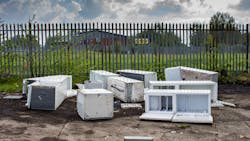Thirteen years after the deadline imposed by the Montreal Protocol for their global phase-out, chlorofluorocarbons (CFCs) are back in the news — and in the atmosphere.
A team of atmospheric scientists found that levels of CFC-113a, -114a, -115, -13 and -112a rose dramatically between 2010 and 2020. The reasons why, however, pose a bit of a mystery.
“We’re paying attention to these emissions now because of the success of the Montreal Protocol,” says Luke Western, a researcher at the National Oceanic and Atmospheric Administration’s (NOAA) global monitoring laboratory and research fellow with the Cabot Institute for the Environment, University of Bristol, U.K.
“CFC emissions from more widespread uses that are now banned have dropped to such low levels that emissions of CFCs from previously minor sources are on our radar now,” he adds.
Western is lead author of a paper describing the research in the April 2023 issue of Nature Geoscience. The study includes experts from the Swiss Federal Laboratories for Materials Science and Technology (Empa), Dübendorf, Switzerland; the Commonwealth Scientific and Industrial Research Organization (CSIRO), Canberra, Australia; the University of California San Diego, California; and the University of Colorado, Boulder, Colorado.
Using measurements from 14 sites around the world and an atmospheric transport model, the researchers found that atmospheric abundances and emissions of the five CFCs have increased. Together, they produce an annual warming effect equivalent to the carbon dioxide emissions from a small country, such as Switzerland.
The researchers determined that for three CFCs they studied — CFC-113a, CFC-114a and CFC-115 — the increased emissions may be partly due to their role during the production of two common hydrofluorocarbons (HFCs) used primarily in refrigeration and air conditioning.
“As the current most likely source of these compounds is byproduct in the fluorocarbons industry, there are concerns of increasing emissions of these CFCs given the production projections for some of these new-generation fluorocarbon products,” says Empa atmospheric chemist and study co-author Martin Vollmer.
However, the Montreal Protocol doesn’t ban the use and creation of CFCs during the production of other chemicals, including HFCs and, more recently, hydrofluoroolefins (HFOs), which were both developed as replacements for CFCs. While such production is discouraged, it is not proscribed.
Meanwhile, even greater mystery surrounds the drivers behind increased CFC-13 and CFC-112a emissions.
The drivers behind increased CFC-13 and CFC-112a emissions remain unknown.
The researchers speculate that CFC-13 may be produced during the deliberate plasma arc destruction of CFC-12 refrigerants from old appliances. However, they admit no information exists on the quantities of CFC-12 destroyed this way, so interconversion levels and eventual emissions of CFC-13 by this route are unclear. They note previous work found aluminum smelting is a minor source of CFC-13 emissions.
“However, unlike global emissions of CFC-11, which dropped rapidly after 2008, emissions of CFC-13 continue through 2020, suggesting a different dominant source,” they write.
The authors describe the source of renewed emissions of CFC-112a as unknown. “We can only speculate qualitatively on a possible resurgence of use as a solvent or a feedstock for fluorovinyl ether production,” they conclude.
“We have investigated what [we know] and excluded these as possibilities. As such, we still don’t know the source,” emphasizes Western.
The researchers have yet to discuss these issues with chemical industry experts, says Western — any communications likely will happen via the Montreal Protocol’s Technology and Economic Assessment Panel. Here, technical information related to alternative technologies investigated is shared with governments and other interested parties.
Western also points to the need for more international monitoring stations, especially in Africa, South America and Asia. “While this would be great, expansion ultimately relies on financial backing,” he notes, adding that a European Union-funded pilot currently is underway, taking preliminary measurements in the Maldives and Bangladesh.
One possible approach to the problem is to make ozone-depleting substances used as feedstocks and produced as byproducts subject to the same controls on production as those for so-called dispersive use under the Montreal Protocol.
“It will take careful consideration by countries signed up to the Protocol to find the necessary controls if they were to decide to try to quash these increasing emissions. This is a complex decision that will require input from scientists, industry, and policymakers,” believes Western.
The main problem here, however, is that while the Montreal Protocol encourages best efforts to mitigate these CFC emissions, not knowing the exact source or mechanism of their release — as is the case for CFC-112a and CFC-13 — makes it hard to eliminate them in the first place.
About the Author
Seán Ottewell
Editor-at-Large
Seán Crevan Ottewell is Chemical Processing's Editor-at-Large. Seán earned his bachelor's of science degree in biochemistry at the University of Warwick and his master's in radiation biochemistry at the University of London. He served as Science Officer with the UK Department of Environment’s Chernobyl Monitoring Unit’s Food Science Radiation Unit, London. His editorial background includes assistant editor, news editor and then editor of The Chemical Engineer, the Institution of Chemical Engineers’ twice monthly technical journal. Prior to joining Chemical Processing in 2012 he was editor of European Chemical Engineer, European Process Engineer, International Power Engineer, and European Laboratory Scientist, with Setform Limited, London.
He is based in East Mayo, Republic of Ireland, where he and his wife Suzi (a maths, biology and chemistry teacher) host guests from all over the world at their holiday cottage in East Mayo.

